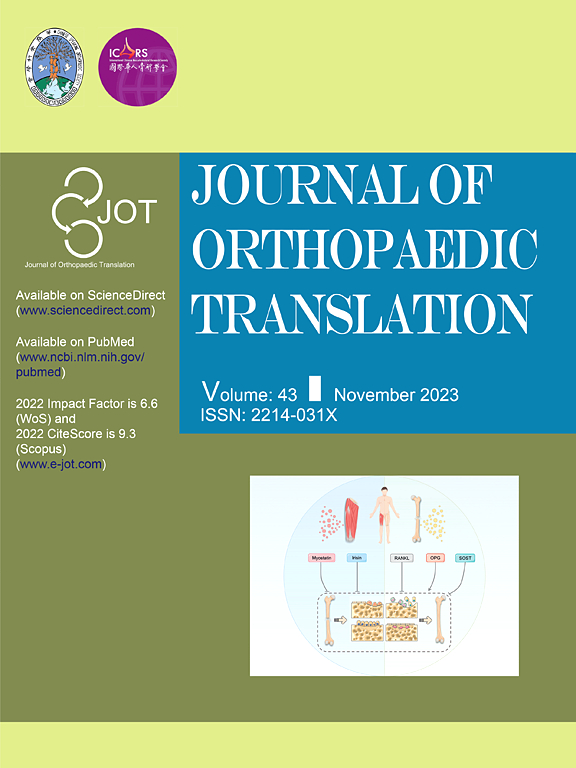同种异体移植物促进假体周围股骨骨丢失的骨骼再生
IF 5.9
1区 医学
Q1 ORTHOPEDICS
引用次数: 0
摘要
背景:假体周围骨丢失是髋关节置换术中常见的临床问题,必须在翻修手术中加以解决,以获得足够的假体稳定性。尽管同种异体骨移植物代表了临床使用的替代材料的标准,但在微观结构,细胞和成分水平上缺乏其再生潜力的证据。方法采用多尺度成像方法,包括接触x线摄影、未钙化组织学、扫描电镜和纳米压痕,对翻修手术中使用同种异体移植多年后获得的人股骨外植体进行扫描。结果同种异体骨与宿主骨结合的骨再生程度与骨缺损深度高度相关(R2 = 0.94, p <;0.001),而同种异体移植物原位时间与植入无明显相关性(R2 = 0.06, p = 0.61)。宿主骨-同种异体移植物界面高度重叠(4.0±2.9 mm),具有骨重构活跃的特征,表现为类骨积累、骨细胞和血管的高丰度。骨水泥通常限制了骨融合过程,宿主骨的骨细胞小管系统到达同种异体移植物界面,引导骨重建。这是第一个基于组织形态学的多尺度评估异体骨移植物用于人类股骨骨丢失的翻修髋关节置换术,证明它们通过骨传导和随后的重塑充分促进骨骼再生。本研究通过独特的样本收集确定了同种异体移植股骨缺损再生的机制和决定因素。虽然我们的结果支持其良好的临床结果,但也证明了不完全结合的科学依据。本文章由计算机程序翻译,如有差异,请以英文原文为准。

Allografts promote skeletal regeneration of periprosthetic femoral bone loss
Background
Periprosthetic bone loss is a common clinical problem in hip arthroplasty that must be addressed during revision surgery to achieve adequate implant stability. Although bone allografts represent the clinical standard among substitute materials used, evidence of their regenerative potential at the microstructural, cellular, and compositional level is lacking.
Methods
A multiscale imaging approach comprising contact radiography, undecalcified histology, scanning electron microscopy, and nanoindentation was employed on human femoral explants obtained postmortem many years after allograft use during revision surgery.
Results
The degree of skeletal regeneration through allograft incorporation between host bone and allograft bone was highly dependent on the defect depth (R2 = 0.94, p < 0.001), while no association between the allograft time in situ and incorporation (R2 = 0.06, p = 0.61) was apparent. The host bone-allograft interface showed a high overlap of 4.0 ± 2.9 mm and was characterized by active bone remodelling, as indicated by osteoid accumulation, high abundance of bone cells and vasculature. While bone cement generally limited the incorporation process, the osteocytic canalicular system of the host bone reached the allograft interface to guide bone remodelling.
Conclusion
This is the first multiscale, histomorphometry-based evaluation of bone allografts used in revision hip arthroplasty for femoral bone loss in humans, demonstrating that they adequately facilitate skeletal regeneration through osteoconduction and subsequent remodelling.
The translational potential of this article
This study identified the mechanisms and determinants of femoral defect regeneration through allografts on the basis of a unique sample collection. While our results support their favourable clinical outcomes, the scientific basis for incomplete incorporation is also demonstrated.
求助全文
通过发布文献求助,成功后即可免费获取论文全文。
去求助
来源期刊

Journal of Orthopaedic Translation
Medicine-Orthopedics and Sports Medicine
CiteScore
11.80
自引率
13.60%
发文量
91
审稿时长
29 days
期刊介绍:
The Journal of Orthopaedic Translation (JOT) is the official peer-reviewed, open access journal of the Chinese Speaking Orthopaedic Society (CSOS) and the International Chinese Musculoskeletal Research Society (ICMRS). It is published quarterly, in January, April, July and October, by Elsevier.
 求助内容:
求助内容: 应助结果提醒方式:
应助结果提醒方式:


